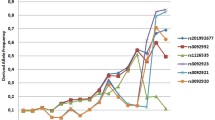Abstract
The aetiology of anti-factor VIII (FVIII) autoantibody formation in acquired haemophilia remains unknown. We hypothesised that encounter of antigenically different, allogeneic FVIII may challenge inhibitor formation after presentation on MHC class II. Eighteen consecutive cases with acquired haemophilia were enrolled (nine females, nine males). A control group comprised 50 male and 50 female healthy blood donors. The coding region of the FVIII gene and the HLA-DRB1 genotype were studied. The presentation of foreign FVIII variants on the patient’s MHC class II alleles was predicted using SYFPEITHI algorithm. A rare FVIII variant (E2004K) was found in one patient with acquired haemophilia after massive transfusion; the 2004 K allele was predicted to be presented on the patient’s HLA-DRB1*0101. Moreover, distribution of a polymorphism (D1241E) was significantly skewed comparing patients and controls. Three of three patients with transfusion-associated disease carried 1241D in homozygous or hemizygous form and were predicted to present 1241E (foreign), but not 1241D (self), on their HLA-DRB1*0301. Therefore, encounter of 1241E may result in the presentation of a new T cell epitope in these patients. The same conditions were not found in any patient with acquired haemophilia of other causes. The expected frequency in the general Caucasoid population undergoing transfusion is 3% to 4%. In conclusion, encounter of variant allogeneic FVIII presented on a suitable MHC background could be a risk factor for inhibitor formation.

Similar content being viewed by others
References
Green D, Lechner K (1981) A survey of 215 non-hemophilic patients with inhibitors to factor VIII. Thromb Haemost 45:200–203
Söhngen D, Specker C, Bach D, Kuntz BM, Burk M, Aul C, Kobbe G, Heyll A, Hollmig KA, Schneider W (1997) Acquired factor VIII inhibitors in nonhemophilic patients. Ann Hematol 74:89–93
Collins P, Macartney N, Davies R, Lees S, Giddings J, Majer R (2004) A population based, unselected, consecutive cohort of patients with acquired haemophilia A. Br J Haematol 124:86–90
Tiede A, Huth-Kuhne A, Oldenburg J, Grossmann R, Geisen U, Krause M, Brand B, Alberio L, Klamroth R, Spannagl M, Knobl P (2009) Immunosuppressive treatment for acquired haemophilia: current practice and future directions in Germany, Austria and Switzerland. Ann Hematol 88:365–370
Peerlinck K, Jacquemin MG, Arnout J, Hoylaerts MF, Gilles JG, Lavend’homme R, Johnson KM, Freson K, Scandella D, Saint-Remy JM, Vermylen J (1999) Antifactor VIII antibody inhibiting allogeneic but not autologous factor VIII in patients with mild hemophilia A. Blood 93:2267–2273
Fijnvandraat K, Turenhout EA, van den Brink EN, ten Cate JW, van Mourik JA, Peters M, Voorberg J (1997) The missense mutation Arg593 –>Cys is related to antibody formation in a patient with mild hemophilia A. Blood 89:4371–4377
Thompson AR, Murphy ME, Liu M, Saenko EL, Healey JF, Lollar P, Scandella D (1997) Loss of tolerance to exogenous and endogenous factor VIII in a mild hemophilia a patient with an Arg593 to Cys mutation. Blood 90:1902–1910
Hay CR, Ludlam CA, Colvin BT, Hill FG, Preston FE, Wasseem N, Bagnall R, Peake IR, Berntorp E, Mauser Bunschoten EP, Fijnvandraat K, Kasper CK, White G, Santagostino E (1998) Factor VIII inhibitors in mild and moderate-severity haemophilia A. UK haemophilia centre directors organisation. Thromb Haemost 79:762–766
Sharathkumar A, Lillicrap D, Blanchette VS, Kern M, Leggo J, Stain AM, Brooker L, Carcao MD (2003) Intensive exposure to factor VIII is a risk factor for inhibitor development in mild hemophilia A. J Thromb Haemost 1:1228–1236
Verbruggen B, Novakova I, Wessels H, Boezeman J, van den Berg M, Mauser-Bunschoten E (1995) The Nijmegen modification of the Bethesda assay for factor VIII:C inhibitors: improved specificity and reliability. Thromb Haemost 73:247–251
Rammensee H, Bachmann J, Emmerich NP, Bachor OA, Stevanovic S (1999) SYFPEITHI: database for MHC ligands and peptide motifs. Immunogenetics 50:213–219
Kemball-Cook G, Tuddenham EGD, Wacey AI (1998) The factor VIII structure and mutation resource site: HAMSTeRS version 4. Nucleic Acids Res 26:216–219
Jacquemin M, Vantomme V, Buhot C, Lavend’homme R, Burny W, Demotte N, Chaux P, Peerlinck K, Vermylen J, Maillere B, Van Der Bruggen P, Saint-Remy JM (2003) CD4+ T-cell clones specific for wild-type factor VIII: a molecular mechanism responsible for a higher incidence of inhibitor formation in mild/moderate hemophilia A. Blood 101:1351–1358
Gilles JG, Saint-Remy JM (1994) Healthy subjects produce both anti-factor VIII and specific anti-idiotypic antibodies. J Clin Invest 94:1496–1505
Singh RR, Hahn BH (1998) Reciprocal T-B determinant spreading develops spontaneously in murine lupus: implications for pathogenesis. Immunol Rev 164:201–208
Lucas GF, Pittman SJ, Davies S, Solanki T, Bruggemann K (1997) Post-transfusion purpura (PTP) associated with anti-HPA-1a, anti-HPA-2b and anti-HPA-3a antibodies. Transfus Med 7:295–299
Alving BM, Weinstein MJ, Finlayson JS, Menitove JE, Fratantoni JC (1995) Fibrin sealant: summary of a conference on characteristics and clinical uses. Transfusion 35:783–790
Banninger H, Hardegger T, Tobler A, Barth A, Schupbach P, Reinhart W, Lämmle B, Furlan M (1993) Fibrin glue in surgery: frequent development of inhibitors of bovine thrombin and human factor V. Br J Haematol 85:528–532
Caers J, Reekmans A, Jochmans K, Naegels S, Mana F, Urbain D, Reynaert H (2003) Factor V inhibitor after injection of human thrombin (tissucol) into a bleeding peptic ulcer. Endoscopy 35:542–544
Casadevall N, Nataf J, Viron B, Kolta A, Kiladjian JJ, Martin-Dupont P, Michaud P, Papo T, Ugo V, Teyssandier I, Varet B, Mayeux P (2002) Pure red-cell aplasia and antierythropoietin antibodies in patients treated with recombinant erythropoietin. N Engl J Med 346:469–475
Guest SS, Levitt L (2003) Pure red-cell aplasia secondary to antierythropoietin antibodies. N Engl J Med 349:2572–2573
Author information
Authors and Affiliations
Corresponding author
Rights and permissions
About this article
Cite this article
Tiede, A., Eisert, R., Czwalinna, A. et al. Acquired haemophilia caused by non-haemophilic factor VIII gene variants. Ann Hematol 89, 607–612 (2010). https://doi.org/10.1007/s00277-009-0887-3
Received:
Accepted:
Published:
Issue Date:
DOI: https://doi.org/10.1007/s00277-009-0887-3




